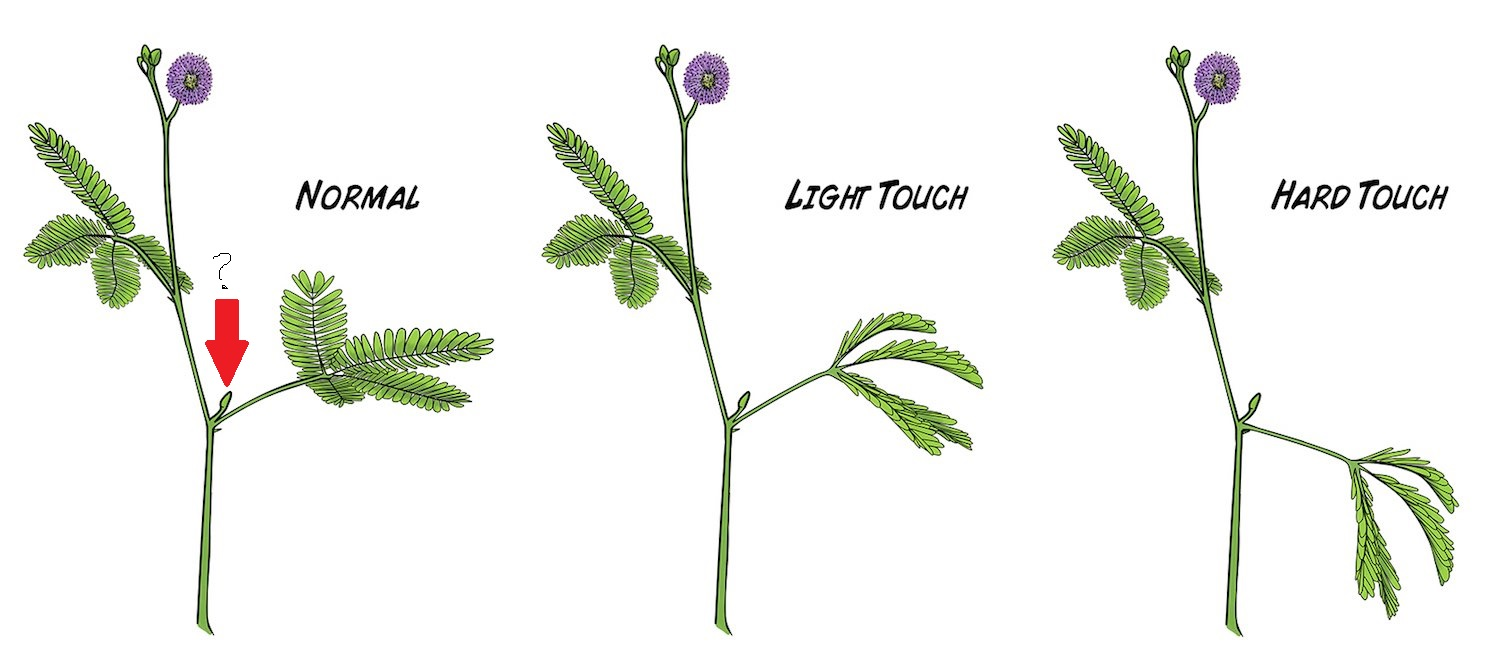
Chui-Mui (Mimosa pudica) plant belongs to which family?
A) Caesalpiniaceae
B) Papilionaceae
C) Mimosoideae
D) None of the above
Answer
501.3k+ views
Hint: Mimosa pudica and Pisum sativum belong to the same family.
Complete Answer:
Here the name of Chui-Mui plant, what comes to our brain is a plant who is shy enough to fold its leaves when touched slightly. Well, there is a scientific reason behind that. Actually, when the Chui-Mui plant folds its leaves when touched, it is said to be showing thigmonastic movement. It is a type of movement which occurs in response to touch. It is non-directional, so it does not involve any growth.
As soon as the Chui-Mui plant is touched, the cells of that point lose water and become flaccid. Soon the stimulus spreads to other cells and the water escapes from the leaves via pulvinus. This results in drooping of leaves.

Now, let’s talk about the plant. It belongs to the family Fabacease, to which our famous legumes also belong. The whole classification of Mimosa pudica is given below:
Kingdom Plantae – Plants
Subkingdom Tracheobionta – Vascular plants
Superdivision Spermatophyta – Seed plants
Division Magnoliophyta – Flowering plants
Class Magnoliopsida – Dicotyledons
Subclass Rosidae
Order Fabales
Family Fabaceae – Pea family
Subfamily - Mimosoideae
Genus Mimosa L. – sensitive plant P
Species Mimosa pudica L. – shameplant
Since, the question is about the family of Mimosa pudica, which is Fabaceae, and in the option, its subfamily is mentioned, we will select option D as the correct answer.
Therefore, the correct answer is option D.
Note: Thigmonasty as seen in Chui-Mui plants is different from thigmotropism as seen in tendrils of money plants. Thigmotropism is the directional movement that also occurs in response to touch, but is responsible for causing the growth of the plant.
Complete Answer:
Here the name of Chui-Mui plant, what comes to our brain is a plant who is shy enough to fold its leaves when touched slightly. Well, there is a scientific reason behind that. Actually, when the Chui-Mui plant folds its leaves when touched, it is said to be showing thigmonastic movement. It is a type of movement which occurs in response to touch. It is non-directional, so it does not involve any growth.
As soon as the Chui-Mui plant is touched, the cells of that point lose water and become flaccid. Soon the stimulus spreads to other cells and the water escapes from the leaves via pulvinus. This results in drooping of leaves.

Now, let’s talk about the plant. It belongs to the family Fabacease, to which our famous legumes also belong. The whole classification of Mimosa pudica is given below:
Kingdom Plantae – Plants
Subkingdom Tracheobionta – Vascular plants
Superdivision Spermatophyta – Seed plants
Division Magnoliophyta – Flowering plants
Class Magnoliopsida – Dicotyledons
Subclass Rosidae
Order Fabales
Family Fabaceae – Pea family
Subfamily - Mimosoideae
Genus Mimosa L. – sensitive plant P
Species Mimosa pudica L. – shameplant
Since, the question is about the family of Mimosa pudica, which is Fabaceae, and in the option, its subfamily is mentioned, we will select option D as the correct answer.
Therefore, the correct answer is option D.
Note: Thigmonasty as seen in Chui-Mui plants is different from thigmotropism as seen in tendrils of money plants. Thigmotropism is the directional movement that also occurs in response to touch, but is responsible for causing the growth of the plant.
Recently Updated Pages
Master Class 9 General Knowledge: Engaging Questions & Answers for Success

Master Class 9 English: Engaging Questions & Answers for Success

Master Class 9 Science: Engaging Questions & Answers for Success

Master Class 9 Social Science: Engaging Questions & Answers for Success

Master Class 9 Maths: Engaging Questions & Answers for Success

Class 9 Question and Answer - Your Ultimate Solutions Guide

Trending doubts
State and prove Bernoullis theorem class 11 physics CBSE

What are Quantum numbers Explain the quantum number class 11 chemistry CBSE

Who built the Grand Trunk Road AChandragupta Maurya class 11 social science CBSE

1 ton equals to A 100 kg B 1000 kg C 10 kg D 10000 class 11 physics CBSE

State the laws of reflection of light

One Metric ton is equal to kg A 10000 B 1000 C 100 class 11 physics CBSE




